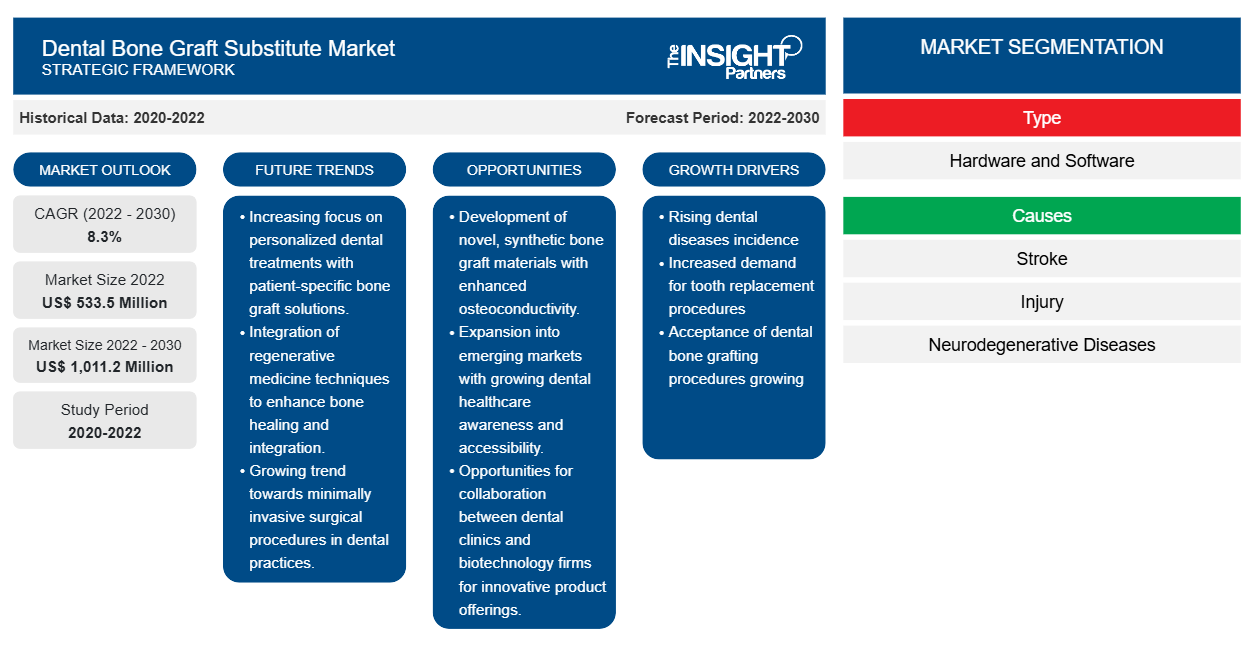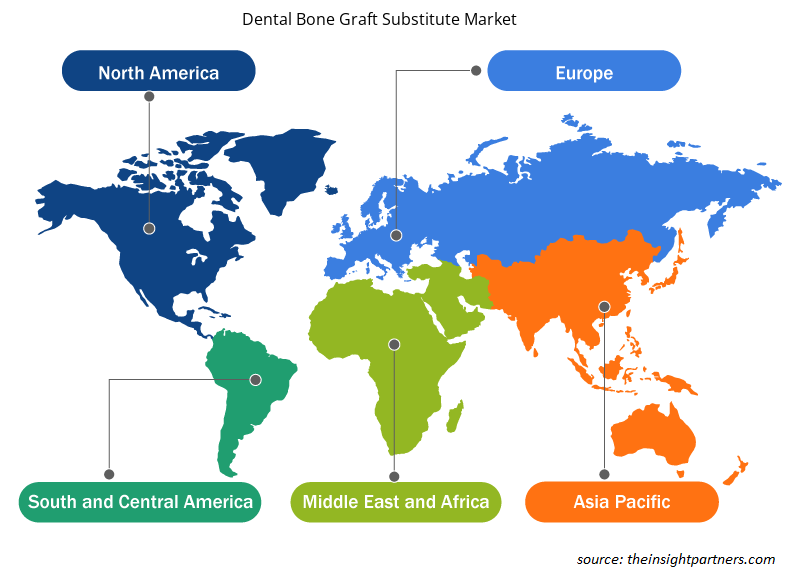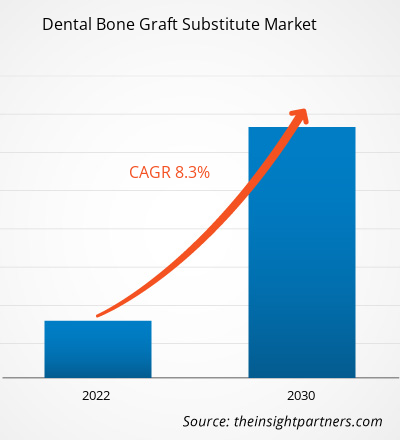[研究报告] 2024年牙科骨移植替代品市场规模为6.232亿美元,预计到2031年将达到10.9848亿美元,预计2025-2031年复合年增长率为7.21%。
市场洞察和分析师观点:
由于牙科疾病的增多以及为了美观而进行的牙科手术数量不断增加,牙科骨移植替代品市场规模正在快速增长。牙科疾病患病率的上升以及政府出台的牙科骨移植替代品支持性举措是牙科骨移植替代品市场最持久的增长动力之一。这些骨移植替代品也用于美容牙科手术,因此美容牙科手术的需求显著增长,尤其是在高收入国家。
增长动力和挑战:
牙周病和口腔癌的负担日益加重,以及对牙科美容手术日益增长的需求推动了牙科骨移植替代品市场的增长。口腔疾病是可以预防的。然而,这些疾病在许多国家都是主要的健康问题,影响着人们的一生。一些常见的牙科问题包括牙周病、龋齿和牙齿脱落。牙科疾病的日益流行导致了对牙齿替换、牙冠、牙冠和牙桥的需求。根据世界卫生组织 (WHO) 《全球口腔健康状况报告》(2022 年),全球约有四分之三的人受到口腔疾病的影响,其中约 35 亿人生活在中等收入国家。此外,全球约有 20 亿人患有恒牙龋齿,约有 5.14 亿儿童患有乳牙龋齿。牙齿歪斜、咬合过度、牙齿间隙和牙齿拥挤等牙科问题的患病率不断上升,催生了对牙科骨移植替代品的需求。例如,根据美国疾病控制与预防中心 (CDC) 的数据,在美国,约有 47.2% 的 30 岁以上成年人患有牙周病,并且发病率随着年龄增长而上升;2020 年,约有 70.1% 的 65 岁以上成年人患有牙周病。牙科疾病患者数量的激增,刺激了对易于快速治疗的牙科骨移植替代品的需求。因此,全球口腔疾病患病率的上升正在推动市场的增长。
预计未来几年利用 CAD/CAM 技术实现牙科数字化将带来新的牙科骨移植替代市场趋势。
定制此报告以满足您的要求
您可以免费定制任何报告,包括本报告的部分内容、国家级分析、Excel 数据包,以及为初创企业和大学提供优惠和折扣
牙科骨移植替代品市场:战略洞察

- 获取此报告的顶级关键市场趋势。此免费样品将包括数据分析,从市场趋势到估计和预测。
报告细分和范围:
牙科骨移植替代品市场分析考虑了以下细分类型、应用、最终用户和地域。按类型,市场分为自体移植、同种异体移植、异种移植、合成骨移植等。根据应用,市场分为牙槽窝保存、牙槽嵴增高、牙周牙齿再生、种植骨再生和上颌窦提升。按最终用户,市场分为医院、牙科诊所和其他。从地域上看,牙科骨移植替代品市场报告的范围主要分为北美(美国、加拿大和墨西哥)、欧洲(西班牙、英国、德国、法国、意大利和欧洲其他地区)、亚太地区(韩国、中国、日本、印度、澳大利亚和亚太其他地区)、中东和非洲(南非、沙特阿拉伯、阿联酋和中东和非洲其他地区)以及南美洲和中美洲(巴西、阿根廷和南美洲和中美洲其他地区)。
节段分析:
根据类型,牙科骨移植替代品市场可细分为自体移植、同种异体移植、异种移植、合成骨移植等。2022 年,自体移植占据了牙科骨移植替代品市场的最大份额。预计异种移植将在 2022 年至 2030 年期间创下牙科骨移植替代品市场的最高复合年增长率。自体移植通常取自接受治疗患者的口内外部位,例如下颌升支、下颌联合、外斜嵴、尺骨近端、髂嵴或桡骨远端,因为这些部位是皮质骨和松质骨的良好来源。自体移植的手术费用较高,且存在较大的手术风险,例如炎症、出血过多、疼痛和感染,因此限制了其在较小骨缺损中的应用。虽然在牙科应用中,其他骨替代物通常用于治疗局部牙槽骨缺损和上颌骨移植,但块状自体移植仍常规用于牙槽嵴增量手术。自体移植是复杂增量手术的首选材料,例如下颌后部无牙重建,因为只有少数骨替代材料可以产生与自体移植材料相当的新骨形成体积。异种移植是来自宿主遗传上无关物种的移植材料。天然骨替代物通过创造有利于骨骼生长的微环境来促进增强的成骨、骨传导和骨诱导潜力。大多数来自牛的异种移植都经过灭菌和处理,以便安全地植入人体组织。这些异种移植可以冷冻干燥或脱矿和脱蛋白。异种移植通常仅以钙化基质的形式分布。马德雷普尔珊瑚和密孔珊瑚被采集并加工成珊瑚衍生颗粒 (CDG) 和其他珊瑚异种移植材料。尽管许多异种移植材料前景光明,但使用异种移植骨替代物仍存在一些局限性。这些局限性包括骨吸收率不稳定、缺乏活细胞和生物成分,以及需要进行组织处理以保留成骨诱导细胞。
牙科骨移植替代市场按应用细分为牙槽窝保存、牙槽嵴增高、牙周牙齿再生、种植骨再生和上颌窦提升。2022年,牙槽窝保存领域占据最大市场份额,预计在2022年至2030年期间将录得最高复合年增长率。
按最终用户细分,市场分为医院、牙科诊所和其他。2022年,牙科诊所占据了牙科骨移植替代品的最大市场份额,预计在2022年至2030年期间将录得最高的复合年增长率。
区域分析:
从地域上看,市场分为北美、欧洲、亚太地区、中东和非洲以及南美和中美。北美是全球牙科骨移植替代市场增长的最大贡献者。预计在 2022 年至 2030 年期间,亚太地区的市场复合年增长率最高。在过去 20 年里,美国的牙科实践发生了重大变化。根据疾病预防控制中心的报告,美国四分之一(26%)的成年人患有未治疗的蛀牙。此外,近一半(约 46%)的 30 岁或以上成年人出现牙龈疾病的迹象,严重牙龈疾病影响约 9% 的成年人。此外,牙科技术的进步为方便牙医和牙科服务用户的工作提供了许多优势,因为他们对美观的要求越来越高。
牙科骨移植替代品市场区域洞察
Insight Partners 的分析师已详尽阐述了预测期内影响牙科骨移植替代品市场的区域趋势和因素。本节还讨论了北美、欧洲、亚太地区、中东和非洲以及南美和中美的牙科骨移植替代品市场细分和地域分布。

- 获取牙科骨移植替代品市场的区域特定数据
牙科骨移植替代品市场报告范围
| 报告属性 | 细节 |
|---|---|
| 2024年的市场规模 | 6.232亿美元 |
| 2031年的市场规模 | 10.9848亿美元 |
| 全球复合年增长率(2025-2031) | 7.21% |
| 史料 | 2021-2023 |
| 预测期 | 2025-2031 |
| 涵盖的领域 | 按类型
|
| 覆盖地区和国家 | 北美
|
| 市场领导者和主要公司简介 |
|
牙科骨移植替代品市场参与者密度:了解其对业务动态的影响
牙科骨移植替代品市场正在快速增长,这得益于终端用户需求的不断增长,而这些需求的驱动因素包括消费者偏好的演变、技术进步以及对产品优势的认知度的提升。随着需求的增长,企业正在扩展产品线,不断创新以满足消费者需求,并抓住新兴趋势,从而进一步推动市场增长。
市场参与者密度是指特定市场或行业内企业或公司的分布情况。它表明特定市场空间内竞争对手(市场参与者)的数量相对于其规模或总市值而言。
在牙科骨移植替代品市场运营的主要公司有:
- 登士柏西诺德公司
- 登腾有限公司
- 盖氏制药公司
- ZimVie公司
- Keystone牙科公司
- 士卓曼控股公司
免责声明:以上列出的公司没有按照任何特定顺序排列。

- 获取牙科骨移植替代市场顶级关键参与者概述
行业发展和未来机遇:
牙科骨移植替代品市场预测基于各种二手和一手研究成果,例如主要公司出版物、协会数据和数据库。市场主要参与者的策略如下:
- 2023年4月,ZimVie公司宣布推出两款产品:RegenerOss CC同种异体移植颗粒和RegenerOss骨移植栓。这两款产品的推出扩展了ZimVie公司用于填充拔牙窝和牙周缺损的生物材料产品组合。这些产品已在北美上市。
竞争格局和重点公司:
牙科骨移植替代市场报告中重点介绍的知名企业包括登士柏西诺德公司 (Dentsply Sirona Inc)、登腾公司 (Dentium Co Ltd)、盖氏制药公司 (Geistlich Pharma AG)、ZimVie 公司、Keystone Dental 公司、士卓曼控股公司 (Straumann Holding AG)、美敦力公司 (Medtronic Plc)、BioHorizons 公司、MEDOSIS 和 LifeNet Health 公司。此外,本研究还对其他几家企业进行了研究和分析,以全面了解市场及其生态系统。这些公司专注于地域扩张和新产品发布,以满足全球消费者日益增长的需求,并扩大其专业产品组合的范围。他们的全球影响力使他们能够服务于庞大的客户群,从而促进市场扩张。
- 历史分析(2 年)、基准年、预测(7 年)及复合年增长率
- PEST和SWOT分析
- 市场规模、价值/数量 - 全球、区域、国家
- 行业和竞争格局
- Excel 数据集
近期报告
相关报告
客户评价
购买理由
- 明智的决策
- 了解市场动态
- 竞争分析
- 客户洞察
- 市场预测
- 风险规避
- 战略规划
- 投资论证
- 识别新兴市场
- 优化营销策略
- 提升运营效率
- 顺应监管趋势






















 获取免费样品 - 牙科骨移植替代品市场
获取免费样品 - 牙科骨移植替代品市场